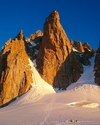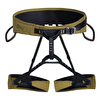Himalayan helicopter rescues
Interview with Gerold Biner, operations manager of Air Zermatt, after the recent helicopter rescue missions in the Himalaya.

 1 / 4
1 / 4
Sling mission at 6800m on Dhaulagiri
 Air Zermatt
Air Zermatt
Manaslu, Himalaya, April 2010. After an emergency call a helicopter took off and and saved the lives of seven alpinists from 6500m. A few days later the helicopter lifted off once again, this time for Annapurna where at an altitude of 6950m - an absolute record - it managed to rescue another three alpinists. And then just a few days ago, another flight, another seven alpinists in difficulty and rescued off Dhaulagiri.
Clearly these aren't the first instances of Himalayan mountaineers being plucked to safety by a helicopter and in recent years there has been a slow but steady increase in these operations. Prime examples which immediately spring to mind are the rescue of Slovenian climber Tomaz Humar off the Rupal Face on Nanga Parbat, the incident of Walter Nones and Simon Kehrer on Nanga Parbat once again and the, unfortunately unsuccessful, attempt last November to rescue Humar on Langtang Lirung. But up until now there has been no professional air rescue service in Nepal and this, undoubtedly, is the real news this season in the Himalaya.
The service - the result of a cooperation between the Nepalese Fishtail Air and the Swiss Air Zermatt - is still in its embryonic, experimental phase and the next training period for the Nepalese pilots is still in search of sponsors. But seeing the important results it has already achieved, one can only hope that it manages to find its right direction, saving lives while at the same time not inducing alpinists into raising the limits in the belief that a rescue is always possibile.
With this in mind, we thought it might be interesting to talk with Gerold Biner, the operations manager of Air Zermatt, to find out more about some mechanisms behind these daring rescue missions though the thinnest air in the world.
Mr Biner, the first question is obligatory: in missions like these, how high are the risks for pilots and rescuers? How far are you pushing the very limits of what is possible?
These kinds of missions are always risky. But by respecting certain operational limits and with alot of team experience, including proper communication, risk analysis, team work and crosschecks, a mission can be carried out without any problems. We have developed all these points over the last 40 years. We are trying to set the limits as reasonable as possible but on the other hand we also have to react to demands and carry out the missions when needed.
What are the current limits?
The operational altitude limit from the Eurocopter manufacturer is 7000 meters. The final decision for a flight regarding weather conditions (visibility, wind and temperature) always depends on a given situation and is taken by the pilot in command. He has the final decision as to whether he will fly a rescue mission or not. Depending on the location, wind and temperatures can have a big influence on whether a rescue mission can be launched or not.
Are rescuers flying with supplementary oxygen?
Yes, the whole crew is using oxygen.
How long is the longline?
The lines vary from 10 up to 200 meters. The technique remains the same though.
At these altitudes, how cold does it get on the longline?
Max speed for the copper is 40 kts. During winter missions in the Alps like on the North Face of the Matterhorn we have experienced temperatures down to -25°C, and so far rescuers have never had any problems with this. In Nepal the temperatures are around -10°C up to 7000 meters, and these days and they will increase. The performance of the helicopter varies dramatically depending on rising temperatures. 10°C warmer temperatures at these altitudes equate to a payload drop of 80 - 100 kg. Since we are operating at the high profile and limit of operations, we always reach the maximum power limit on the B3 helicopter. That's why we always attempt to leave as early in the morning as possible, to fly under cold conditions.
How long can the helicopter operate before having to land and refuel?
We carry supplementary fuel in canes or drums to base camp or locations nearby so that we can then use the helicopter as light as possible. We can fly up to 30 minutes before refuelling. If necessary, we can order a second chopper with additional fuel.
All of this must be extremely expensive. Who pays for the missions?
The costs for the first visit and training of the Nepalese team in Switzerland last March were paid for in toto by Air Zermatt and the rescue station of Zermatt. The costs for an actual rescue have to be paid by the expedition to which the climbers or sherpas in need belong to. We are looking for sponsors to cover the costs for the next Nepalese team training.
Last question which you have surely thought about in depth. What consequences do you think will a rescue team of this sort have on Himalayan mountaineering?
Our personal opinion is that this will not have a big influence of Himalayan mountaineering. The negative development started 15 or more years ago. The commercialisation of Himalayan mountaineering started even earlier still. Since then, clients have been guided up Everest and you nowadays you can register for any peak you want. If you talk to experts, most of them think that over 50% of all climbers in the Himalayas are not qualified for their climbs. This also holds true for the Alps. In earlier times only adventurers and good climbers went to the highest peaks in the world. Creating competitions like first ascents, new routes and 7 summits has also resulted in too many climbers killed in the Himalayas.
So...
Up to a certain degree, the helicopter rescue service will help all climbers and also Sherpas in critical and dangerous situations. This project will also be positive for the local people. During the rescue on Manaslu for example, 3 out of the 7 rescued climbers were Sherpas! With the rescue mission on Langtang Lirung last year we created a new situation and we felt responsible to support the local helicopter company in this matter. The strategy of Air Zermatt was, and still is, to train the Nepali crew up to a level where in a few years they are able to perform such missions without us!
Clearly these aren't the first instances of Himalayan mountaineers being plucked to safety by a helicopter and in recent years there has been a slow but steady increase in these operations. Prime examples which immediately spring to mind are the rescue of Slovenian climber Tomaz Humar off the Rupal Face on Nanga Parbat, the incident of Walter Nones and Simon Kehrer on Nanga Parbat once again and the, unfortunately unsuccessful, attempt last November to rescue Humar on Langtang Lirung. But up until now there has been no professional air rescue service in Nepal and this, undoubtedly, is the real news this season in the Himalaya.
The service - the result of a cooperation between the Nepalese Fishtail Air and the Swiss Air Zermatt - is still in its embryonic, experimental phase and the next training period for the Nepalese pilots is still in search of sponsors. But seeing the important results it has already achieved, one can only hope that it manages to find its right direction, saving lives while at the same time not inducing alpinists into raising the limits in the belief that a rescue is always possibile.
With this in mind, we thought it might be interesting to talk with Gerold Biner, the operations manager of Air Zermatt, to find out more about some mechanisms behind these daring rescue missions though the thinnest air in the world.
Mr Biner, the first question is obligatory: in missions like these, how high are the risks for pilots and rescuers? How far are you pushing the very limits of what is possible?
These kinds of missions are always risky. But by respecting certain operational limits and with alot of team experience, including proper communication, risk analysis, team work and crosschecks, a mission can be carried out without any problems. We have developed all these points over the last 40 years. We are trying to set the limits as reasonable as possible but on the other hand we also have to react to demands and carry out the missions when needed.
What are the current limits?
The operational altitude limit from the Eurocopter manufacturer is 7000 meters. The final decision for a flight regarding weather conditions (visibility, wind and temperature) always depends on a given situation and is taken by the pilot in command. He has the final decision as to whether he will fly a rescue mission or not. Depending on the location, wind and temperatures can have a big influence on whether a rescue mission can be launched or not.
Are rescuers flying with supplementary oxygen?
Yes, the whole crew is using oxygen.
How long is the longline?
The lines vary from 10 up to 200 meters. The technique remains the same though.
At these altitudes, how cold does it get on the longline?
Max speed for the copper is 40 kts. During winter missions in the Alps like on the North Face of the Matterhorn we have experienced temperatures down to -25°C, and so far rescuers have never had any problems with this. In Nepal the temperatures are around -10°C up to 7000 meters, and these days and they will increase. The performance of the helicopter varies dramatically depending on rising temperatures. 10°C warmer temperatures at these altitudes equate to a payload drop of 80 - 100 kg. Since we are operating at the high profile and limit of operations, we always reach the maximum power limit on the B3 helicopter. That's why we always attempt to leave as early in the morning as possible, to fly under cold conditions.
How long can the helicopter operate before having to land and refuel?
We carry supplementary fuel in canes or drums to base camp or locations nearby so that we can then use the helicopter as light as possible. We can fly up to 30 minutes before refuelling. If necessary, we can order a second chopper with additional fuel.
All of this must be extremely expensive. Who pays for the missions?
The costs for the first visit and training of the Nepalese team in Switzerland last March were paid for in toto by Air Zermatt and the rescue station of Zermatt. The costs for an actual rescue have to be paid by the expedition to which the climbers or sherpas in need belong to. We are looking for sponsors to cover the costs for the next Nepalese team training.
Last question which you have surely thought about in depth. What consequences do you think will a rescue team of this sort have on Himalayan mountaineering?
Our personal opinion is that this will not have a big influence of Himalayan mountaineering. The negative development started 15 or more years ago. The commercialisation of Himalayan mountaineering started even earlier still. Since then, clients have been guided up Everest and you nowadays you can register for any peak you want. If you talk to experts, most of them think that over 50% of all climbers in the Himalayas are not qualified for their climbs. This also holds true for the Alps. In earlier times only adventurers and good climbers went to the highest peaks in the world. Creating competitions like first ascents, new routes and 7 summits has also resulted in too many climbers killed in the Himalayas.
So...
Up to a certain degree, the helicopter rescue service will help all climbers and also Sherpas in critical and dangerous situations. This project will also be positive for the local people. During the rescue on Manaslu for example, 3 out of the 7 rescued climbers were Sherpas! With the rescue mission on Langtang Lirung last year we created a new situation and we felt responsible to support the local helicopter company in this matter. The strategy of Air Zermatt was, and still is, to train the Nepali crew up to a level where in a few years they are able to perform such missions without us!
Note:
| Links Planetmountain | |
| Annapurna, successful and failed rescues | |
| Links www | |
| www.air-zermatt.ch | |
Latest news
Expo / News
Expo / Products
Light and flexible hiking shoeit
Highly breathable skyrunning t-shirt
High-end one-buckle climbing harness combining comfort and light weight.
High quality suede gloves designed for via ferrata.
Karpos Rock Evo Pants, Perfect pants for any summer outdoor activity.
Light climbing helmet with kevlar reinforcements.



 Copia link
Copia link























